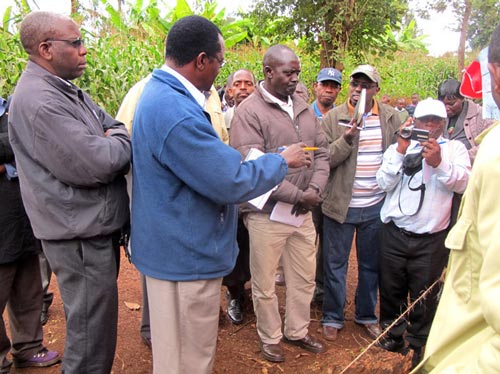 A delegation of scientists from South Sudan, Rwanda, and Uganda —the spillover countries of the Sustainable Intensification of Maize-Legume Systems for Food Security in Eastern and Southern Africa (SIMLESA) initiative— visited Embu, Kenya, during 18-20 July 2012, to gain hands-on experience in implementing the program and to learn about its impact on livelihoods of smallholder farmers.
A delegation of scientists from South Sudan, Rwanda, and Uganda —the spillover countries of the Sustainable Intensification of Maize-Legume Systems for Food Security in Eastern and Southern Africa (SIMLESA) initiative— visited Embu, Kenya, during 18-20 July 2012, to gain hands-on experience in implementing the program and to learn about its impact on livelihoods of smallholder farmers.
The delegation comprised Leonidas Dusengemungu, Albert Ruhakana, and Alphonse Nyobanyire from Rwanda; Luka Atwok, Anna Itwari, and Cirino Oketayoyt from South Sudan; and Drake N. Mubiru, William Nanyenya, and Godfrey Otim from Uganda. The scientists found the visit very educative and informative. They learned about the implementation of SIMLESA in Kenya and the role of national agricultural research institutions, the Kenya Agricultural Research Institute (KARI) in particular, in the process. They also gained insights into the innovation platform establishment and arising challenges, maize-beans intercropping and timing, challenges and coping strategies for the implementation of SIMLESA, and the level of adaptation of SIMLESA technologies in Kenya.
In his introductory remarks, Stephen Njoka, KARI-Embu Center Director, explained the Center’s mandate, activities, opportunities, and challenges in conducting agricultural research in Kenya. He noted that research programs at KARI-Embu range from food crops and crop health, natural resource management, horticultural and industrial crops, animal production and health research, outreach and partnerships, to cross-cutting programs, such as socioeconomics and applied statistics. The Center also offers advisory services, such as technical support for partners and capacity development for other service providers, including extension service providers and NGOs. Alfred Micheni, KARI Agronomist and SIMLESA Site Coordinator for eastern Kenya, explained that the western and eastern sites in Kenya had been selected because of their potential for the highest impact. This was determined by their agricultural production constraints: low soil fertility, erratic rainfall, high cost of farm inputs, high incidences of pests and diseases, high cost of credit, and small land sizes.
The scientists had a chance to interact with farmers participating in SIMLESA during a farmers’ field day in Kyeni Division, Embu County, on 20 July 2012. The field day was hosted by the Kyeni Innovation Platform and showcased various treatments under conservation agriculture (CA): maize-legume intercrop, minimum tillage, furrows and ridges, use of herbicides, residue retention, and variety selection. The scientists also had the opportunity to compare the robust crops under CA with those under conventional agricultural practices which were unable to cope with the prolonged drought in the region.
Charles Nkonge, SIMLESA National Coordinator, stressed the importance of the innovation platforms used by the program to evaluate and scale out maizelegume intensification technologies and knowledge in a participatory manner. Other strategies for scaling out include farmer exchange visits and participatory exploratory demonstrations. Nkonge stressed the importance of the participatory nature of the evaluations; through cooperation between the farmers and other collaborators, experimental designs of some of the treatments were adjusted to achieve more efficiency. For instance, the design of maize-pigeon pea intercropping trial was changed from intercropping of one pigeon-pea row between two rows of maize, giving one crop of maize and pigeon pea per season, to five rows of maize between two rows of pigeon pea and one row of common beans between two rows of maize. With the new design, two crops of maize, two crops of beans, and one crop of pigeon pea are harvested every year. This demonstration of successful practices allowed the representatives from SIMLESA Spillover countries to leave Kenya feeling optimistic about the new partnership.
 Capacity development
Capacity development 
